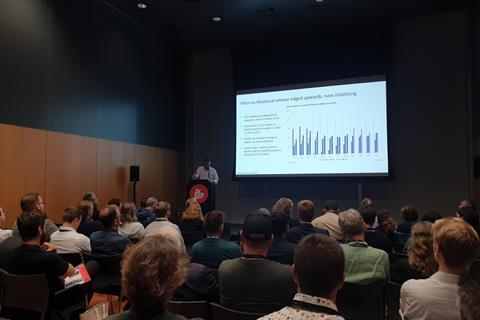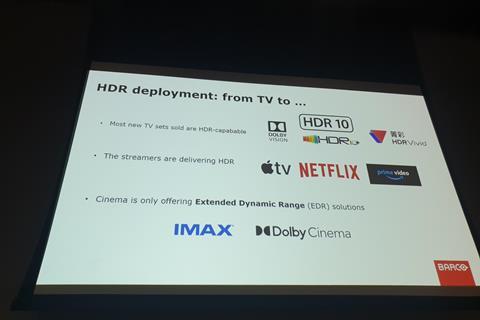Covid-related venue closures and the giant rise of streaming have cost the cinema culture a significant loss in audience numbers, and now with the aftershock of the Hollywood writers’ strike, cinema needs an innovative force if it is to avoid a prolonged decline in viewership, writes Sheryl Hickey.
These and other questions around the current cinema culture landscape provided the backdrop to a longstanding partner session, ‘EDCF: Cinema Looks Forward to a Changing Future’, which took place at IBC2023.

Experts from technology innovation across the cinema content chain explored the data gathered by research analysts Omdia, and offered insights and solutions to replenish cinema visitor numbers, giving predictions on new ways to engage and entice audiences of the future.
David Hancock, Chief Analyst of OMDIA, emphasised that for cinemas, the most positive effect Covid had on cinema was: “Studios realising that cinemas create value – if you go straight to streaming, where is your money coming in? There’s no money and there’s no hype.”
Read more Delving Deeper: Will AI help us solve humanity’s biggest challenges?
A medley of speakers followed on to discuss the future of cinema and what developments need to be made to keep audiences engaged in a rapidly transforming media and production landscape, each representing different corners of the industry from exhibiting in cinematic spaces to postproduction.
The Strike Aftermath
Hancock showed data that proved the cultural relevance of a primary form of film release - creating value in the chain, and stressed that while there have been spikes of audiences flooding back to cinemas thanks to No Time to Die and ‘Barbenheimer’, you still need films to have a consistent audience flow.
At the IBC2023 talk, Hancock also predicted the continuing impact of the strike, “if it stops now… then it will probably be okay. I think because it’s been two, three months, probably with what’s already in the pipeline being shot abroad… If it carries on going then the effects will start to be felt at the end of 2024 because there’s been enough held back up and (then) pushed out.” He stressed the unfortunate timing of the strikes for cinema culture, “because we’re just getting back to where it was after COVID. And what we needed was momentum.”
With the strike now officially ended, with increases to minimum wage and compensation, plus other terms in the WGA’s favour, there are still the domino effect of more pushbacks in productions – which means more delays for post-production.
Innovative tech: The antidote for cinema recovery
At EDCF: Cinema Looks Forward to a Changing Future, Hancock pointed out that whilst some countries have seen a mass closure of cinema venues, which in turn has had a lasting effect, worldwide there has not a mass closure of cinemas.

“If you look forward…we’re looking at screen growth in some countries that were growing before. We’re looking at screen stability. We’re looking at possible reductions of screens and countries that are struggling before and some countries are struggling because of the screen infrastructure… One thing that has changed in the world is an [increase in the] number of things you can do with your time and money - having a good cinema screen base is fundamental to individual cinema.”
Speakers responded by coming to the floor with hope that whilst the pandemic had a damaging effect on cinema culture, boosting visitor numbers is still on the cards through advanced tech, content creation and innovation.
Cinema is already seeing the adoption of laser projection, the rise of HDR to the Cinema Screen – which Barco showcased at its premiere during the 2023 Cannes Film Festival, alongside a massive rise in Virtual Production.
One setback for cinema which was addressed at the talk was that streamers are using HDR but cinema still uses EDR. However, there is scope for colour grading in HDR as was raised in a key message from Tom Bert, VP Product - Cinema, Barco, that film is “an industry converting to laser, postproduction cannot stay behind.”
AI also plays a vital part through subtitle generation in the cloud via media production software – meaning different parts of the production can be moved to cloud, as well as post-production workflows. AI based transcription which is used as a time saver - but human skill is still required for quality control.
Industry collaboration and insight are also crucial to get numbers to where they used to be, as Hancock put it, the main thing is to “get people back into making film… So it has there is a scar industry and there’s a there’s an impact. And that’s reduced the love to invest in technology, new sites. You see it’s everything.”
Keeping faith in the flicks
With Gareth Edwards’ and Oscar winning cinematographer Grieg Fraser’s The Creator tipped to be the future of blockbusters for their medium budget approach with high-end VFX results, plus others in the bag for the closing of 2023 and beyond, including Warner Bros. Wonka made by the people behind Paddington, Dune Part Two, and the Apple Original and Ridley Scott film Napoleon, cinema is expected to keep drawing in the bigger crowds.
But to continually engage and compete with streamers warrants brains and new developments behind the silver screen.
Talk moderator Julian Pinn, Vice President, EDCF, summed up with an upbeat message, “The world is looking for cultural moments and cinema is giving them that.”
Read more Cuebric Generative AI: Now We Are All Image Makers
























No comments yet